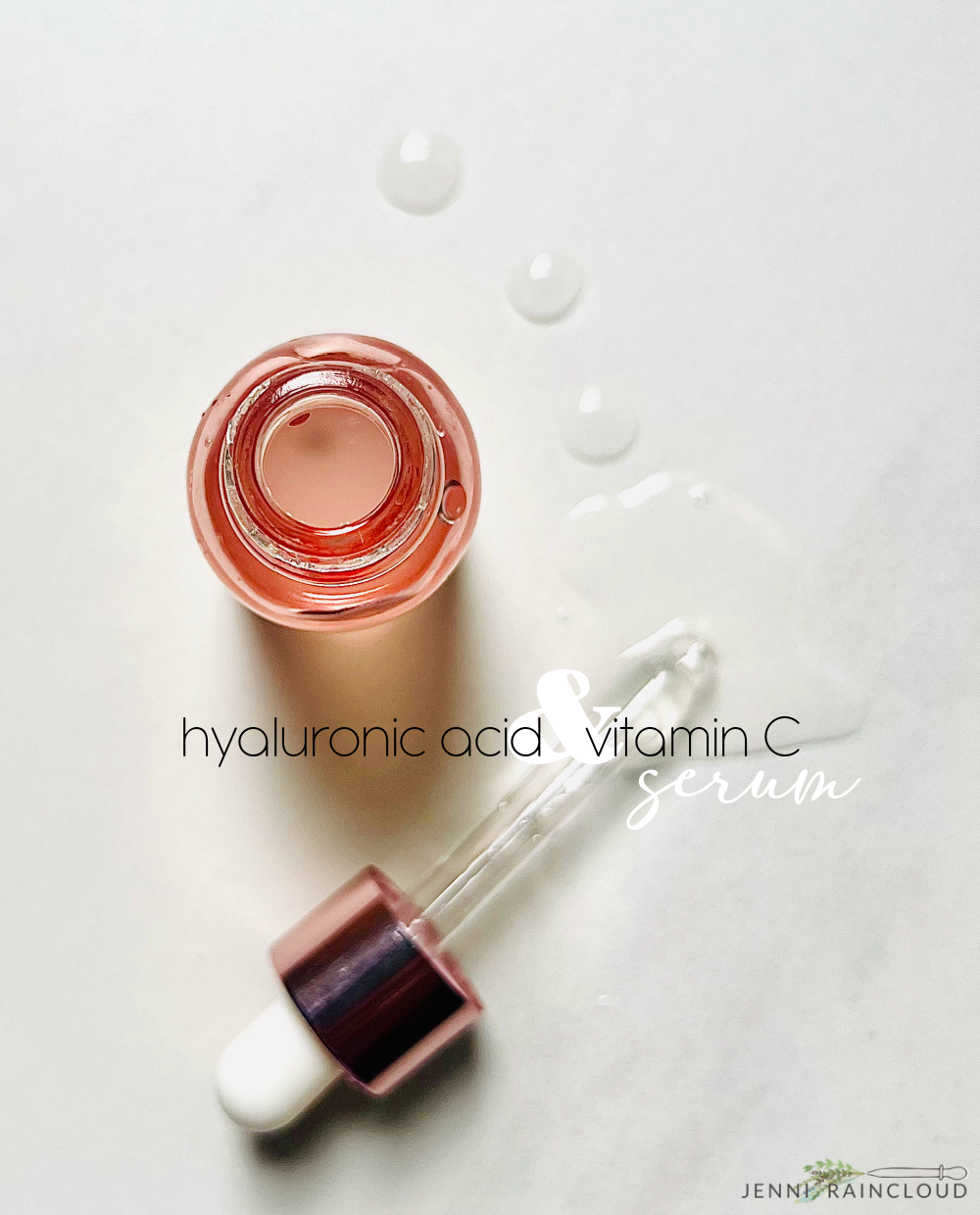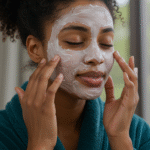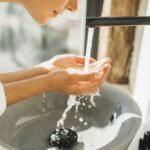Two of the most effective anti aging tools are hyaluronic acid and vitamin C. Today, we’re going to learn how to make one powerhouse of a serum with both ingredients. This DIY hyaluronic acid and vitamin C serum is easy and quick to make, has a relatively good shelf life and goes a LONG way with hydrating, smoothing, evening and regenerating your skin. This is a MUST HAVE DIY that I’m so excited to share!

I’ve been experimenting with different hyaluronic acid powders and vitamin C additives in order to make the perfect hybrid serum. It’s taken some time and trying different brands and a lot of failed attempts but I’ve finally cracked the code. The best part is, this serum is extremely effective and on top of that, it’s easy to make.
I have tried many different hyaluronic acid powders as well as vitamin c powders. Every time I would try to make this serum something would go wrong. Once I found a liquid vitamin C that was actually much more stable than the usual powders, I jumped on it! This particular type of vitamin C is a must in this recipe and any other vitamin C recipes as well. Typically vitamin C is very prone to oxidation and will only stay effective for a week at best which made DIY Vitamin C serums a pain to make.
The hyaluronic acid I chose gives the best gel texture. Many hyaluronic acid powders are very effective but tend to be very watery which does not indicate inefficiency but THIS particular powder gives such a nice gel consistency. I’ve also used THIS hyaluronic acid as well and like it.
Skin Benefits of Hyaluronic Acid:
Our skin makes its own hyaluronic acid but as we age it’s production drops off drastically. Hyaluronic acid attracts water like a sponge and holds on to it by creating a barrier. It helps smooth wrinkles and plumps the skin. An abundance of hyaluronic acid in the skin increases elasticity and heals and regenerates damaged tissue.
Youthful skin is full of hyaluronic acid. Supplementing it after the age of 40 is a must and will go a long way when it comes to smoothing and hydrating skin.
The great thing about hyaluronic acid is that it is a sufficient moisturizer for acne prone skin or oily skin types. It won’t clog the pores and soaks into the skin instantly. For more information on hyaluronic acid, check out my DIY Hyaluronic Acid Serum post.
Benefits of Vitamin C:
Vitamin C’s main claim to fame is that it brightens the skin and increases collagen production. It is a powerful anti aging tool. Vitamin C has been known to help lighten age spots as well. Vitamin C can tighten and reduce sagging skin and even protects against sun damage. Many skincare experts would say it is 100% necessary in an anti aging skincare routine.
Related Post: DIY Vitamin C Serum Benefits
Why Make a Serum That Contains Both HA and Vitamin C?
Hyaluronic acid and vitamin C complement each other in the best way. Each possess a quality the other doesn’t, meaning they are a great asset when used together. Vitamin C will exfoliate which can dry out the skin while hyaluronic acid helps regenerate and hydrate the skin. While vitamin C brightens and protects, hyaluronic acid hydrates and replenishes.
Hyaluronic acid and vitamin C are quite the dynamic duo and when using both together you can effectively combat the signs of aging!
What is Vitamin C, 3-Glyceryl Ascorbate?
According to Lotioncrafter:
Vitamin C, 3-Glyceryl Ascorbate is a vitamin C derivative that is more stable than powder-derived vitamin C alternatives. Vitamin C, 3-Glyceryl Ascorbate does not discolor over time due to degradation, and since it is a stable product, it will not alter a formulations color or content. Vitamin C, 3-Glyceryl Ascorbate offers the benefits of Vitamin C in a formulation without the instability or degradation of a traditional Vitamin C option.
Key Benefits
-
Behaves as an anti-oxidant to block UV damage and damage caused by stress, also brightens skin and improves skin regeneration.
-
Suppresses melanin production for improvement of spots
-
Conditions and moisturizes skin
- Enhances collagen production for improved elasticity
Vitamin C, 3 Glyceryl Ascorbate can only be added into water based ingredients or added into the water phase of a lotion. This vitamin C should make up 2-10% of a recipe.
This particular vitamin C is around $15 per 1 ounce. 1 ounce will make quite a few serums and other DIYs. If you use 10% vitamin C in every DIY serum, you can make around 30, 1 ounce serums.
This ingredient can be used in many more DIYs. In fact, I will be sharing it in a new eye serum next week!
Related Post: DIY Vitamin C Sheet Mask Recipe

What You’ll Need to Make Hyaluronic Acid & Vitamin C Serum:
*You must first make a hyaluronic acid base before you add the vitamin C. This base is easy to make but will need to sit in the fridge for around 6-12 hours so that the powder will dissolve and thicken up the water. I’m not sure if you can add the vitamin C when making the base. My gut tells me it should be added once your HA base is finished.
How To Make A Hyaluronic Acid Base:
-
- Add 7 tablespoons of distilled water or hydrosol to a bowl.
- Sprinkle 1 teaspoon of hyaluronic acid powder over the top of the water. Don’t bother mixing.
- Place in the fridge for 6-12 hours. The powder will gradually dissolve while thickening the water.
- After the mixture has thickened, pour into a condiment bottle.
Related Post: After Sun Balm w/ Hyaluronic Acid


How to Make Hyaluronic Acid/Vitamin C Serum:
- In a 1 oz glass dropper bottle or treatment pump bottle add 1/4 tsp. of Vitamin C.
- Add 1/4 tsp. of leucidal liquid.
- Top off with the HA serum base using the condiment bottle.
Recipe Notes:
- This recipe makes around 4 ounces. I recommend using 1/2-1 ounces at a time and leaving the rest in the fridge.
- The shelf life is around 1-2 months with the preservative (leucidal liquid) and the excess kept in the fridge.
- If your hyaluronic acid powder stay clumpy (which is very unusual with the brand I link) you may use a high powered frother or a blender to smooth it out.
When To Use a Serum:
After cleansing and toning, a serum should be used. It is best to apply a serum when the skin is still slightly damp from the toner. After your serum, I recommend using a facial oil. If you have oily skin, this serum may be enough and a moisturizer can be skipped.
You can use this serum morning and night. If you plan to use once a day, I recommend you use it in the morning.
Is a Preservative Necessary?
YES. I whipped this recipe up over a month ago, put it in a 1/2 ounce bottle and left the rest in the fridge. In order to take pics for this post I needed the rest of the serum I had kept in the fridge. When I filled my empty bottle up with it it had clearly molded. Even in the fridge there was mold. So 100% yes, do not skimp on the preservative. Leucidal liquid is a broad spectrum preservative that is used in products that are labeled “natural” and certified organic. It is very safe to use and is affordable. Grab a bottle when you buy the Vitamin C at Lotioncrafter. It can be used in all water based DIYs like toners and other serums. It is not recommended for lotions however.
Extra Add-In Ingredients:
I mentioned above that you may want to use a hydrosol as a base for your HA powder instead of water. Using a hydrosol can boost skin benefits as well as give your serum a lovely smell. My favorites are rose and lavender. If you choose to stick to water, I recommend using distilled water.
Essential oils can also be added for more anti aging action. My favorite anti aging essential oils are helichrysum, geranium, cypress, ylang ylang and lavender. I would add about 5 drops per 1 ounce of serum.
Vegetable glycerin is often added to water based products since it is a humectant and will attract water to the skin. It is also known for its slip and can improve the texture of your serum. I personally don’t think it’s necessary in a hyaluronic acid serum.
I’m super excited about this DIY serum. I’ve been using mine for over a month and just made a new batch. At this point in the summer I typically am seeing hyperpigmentation and one sun spot in particular that raises. I am seeing none of that and my raised spot is no longer raised and is less noticeable than it was in the winter! My skin feels softer than ever as well. This will be a DIY serum I will stick with and I highly encourage you to make some too. It is a very simple DIY you can make in minutes!
xx, Jenni
PIN IT!!





